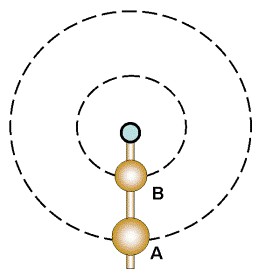- Linear
- Angular
Linear speed is defined as the distance travelled for a given time.
Angular speed is defined as the angle covered for a given time.
Are they proportional ?
Or are they related in any sense?
Let us take 2 pendulums hung on a slim rotating rod for analysis.

If the 2 pendulums (A and B) rotate one full cycle, the time taken by them is the same.
They covered the same amount of angular distance (360 degree) within the same amount of time.
This showed that they have exactly the SAME angular speed.
But is the Linear speed similar?
The length of the 2 circumferences travelled by the individual pendulums are not the same.
The linear length or distance is therefore NOT the same.
Length = 2 x (pi) x radius.
They took the same time to complete one full cycle, though.
The linear speed is thus DIFFERENT, having travelled different length for the same amount of time.
In this case, the angular speed is the SAME whereas the linear speed is different. Pendulum A has a higher linear speed compared with pendulum B.
Can the angular speed be different and linear speed made to be the same?
If the same slim rod is used, the answer is NO.
But if they are held by different rods, like that of the traditional analogue clock, the answer is YES.
For the linear speeds to be the same, pendulum A has to take a longer time to complete one cycle compared to pendulum B timing.
In this case, their linear speeds are the SAME while the angular speed will be DIFFERENT. This is so, since, same angular coverage but different time taken.
Why are we talking so much about this?
This is an "old" principle that was applied to the famous grandfather's clock. The setting of the pendulum position along the swinging rod (or string) is the key to the time accuracy of the clock. Ancient people has used this understanding to produce something useful for their daily needs, and this is mathematics!
Wonderful isn't it? :)
.
+copy.jpg)







5 comments:
Great. I am a HS Math Teacher (AP*Cal BC Teacher) and this explanation makes lot of sense than the one given in Sullivan 9th edition PreCal book.
Nice to know that the post helps.
Cheers!
I, too, am a HS math teacher and I find this explanation far superior to the one found in Larson 4th Ed. Precalc text.
Thanks. This is a strong encouragement to me, and I hope the post serves maths learners well.
Homeschool mom who found this explanation much easier to explain than the one in the book! Thanks!
Post a Comment